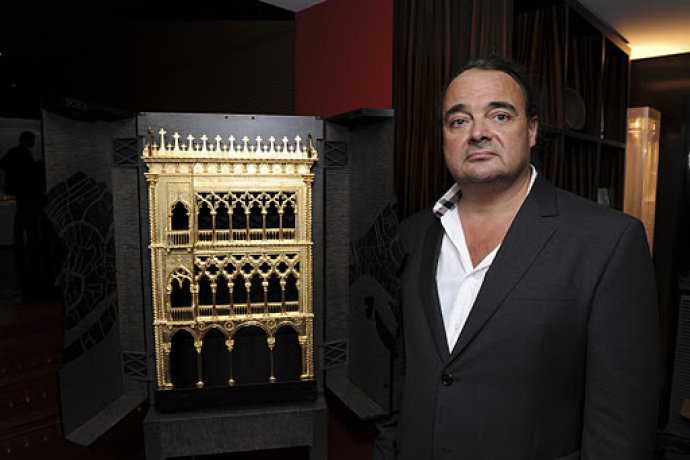François Staub, you have directed a well-established cabinet making company in the Lausanne area for many years. Are you branching out in a new direction with this creation of a collection representing the Fine Art of Cabinet Making?
In our 20 years of activity in custom-built joinery, we have worked for the great names in watch making and for some very specific architectural projects. We have developed our professional skills, which combine traditional techniques with technological innovations, such as computeraided drawing and digitally controlled machines. So we now have high- performing capacity and also the flexibilityof using all these techniques in different ways. Because the tools in themselves are not enough, one has to learn how to master them and then seek new destinations, other lands to explore. With the collection of “meubles à secrets” we hope to reendow our craft with the prestige which it earned over past centuries, hence the term “The Fine Art of Cabinet Making”.
The first piece “Homage to Venice” has seen the light of day. What are the reasons behind an adventure such as this?
I often hear people say “we can’t work like the ancient craftsmen did: we’re losing the skills; it’s too time-consuming; today, the only thing that counts is profitability!” I wanted to meet the challenge, perhaps just out of a spirit of contradiction, and to show that by giving shape to a dream, you can make it reality. The main thing is to visualize the project, to imagine it as it will be. Then all that remains is to provide its material form. It’s like a film maker, when he has envisaged the scene in every detail, with the actors and the lights, only then can he film it.
But isn’t this all a bit unrealistic? As far as I know, there was no commission for this piece.
If this had been a commission we wouldn’t have had the same freedom. Our job is to satisfy our clients’ wishes; in the building trade, the client is referred to as the Master of Works (in French, Maître de l’ouvrage), whereas in this case it is the piece itself who is our Master.
How did you get the idea of a collection of unique pieces?
I was trying to return to the notion of the creative craftsman, inspired by Renaissance times when a man would put all his skills and knowledge at the service of the piece he was working on.
When Mr Pascal Cuénot arrived at our workshop, I thought to myself: this is who we need to launch the collection. He has trained as a cabinet maker/carver and has also worked as a piano and harp maker. I took him on after talking to him about this new and unique project, which I knew would correspond to his level of skill and experience.
One of Pascal’s qualities is his total engagement in the project. He shaped all the parts, turned each column of the façade individually, carved the gothic tracery with perfect accuracy, sometimes with the help of a watchmaker’s magnifying glass. His hand is unwavering and he involved himself in the adventure with constancy and great modesty. I see him as the soloist in our orchestra.
Obviously other people also worked on the piece?
A creation like Homage to Venice is the work of a team. Alongside the sculptor, another cabinet maker, Mr. Jean-Luc Frey, was responsible for digitizing the plans and programming the digitally controlled machine. All the elements of the internal structure as well as numerous pieces of marquetry were tooled using modern techniques.
In one way or another, all the members of our 10-strong team have contributed to the outcome of the project. The workshop and all our craftsmen represent a matrix capable of giving birth to such projects.
What was your own role in its realization?
My role was first and foremost to conceive the project and then to give it a shape, to draw it. The drawing is the bedrock of the construction. If there were to be an order for another version of the same piece, all the plans are ready for its execution. There are five potential versions of the original, unique piece, like so many different interpretations of the same musical score.
I also worked closely with the polisher on the finish. Grey, for instance, is one of the most difficult shades to use on wood.
Realizing a piece like this is a long and exacting task, I imagine?
Its design, as well as its construction, was staged. We started with the carved façade. Our plans of the façade were based on different documents, such as photographs and old engravings, and then it took us seven months to make the different parts. While Pascal was carving, I was already designing the elements of the next stage. All in all, Homage to Venice represents three years’ work.
There are times when, like someone walking in the desert, you do not realize that you are actually progressing. The piece imposes its own rhythm. It was only after two and a half years that we began to glimpse a date when the work might be finished.
This first piece pays homage to Venice. Can you explain your choice?
Like so many others, I have always been fascinated by the city and the dreams, unexpected events and power that emanate from her; there is also the aspect of her invincibility.
The idea was not to create an accurate, historical reproduction but rather to work on perceptions and the sensual impact of the city. This Homage also embraces certain elements which struck my imagination. And so you could say that it is a personal interpretation, rooted in the cultural collective unconscious.
I returned to Venice several times over these three years of creation to immerse myself in the beauty of the place and the fabulous inheritance left by its craftsmen. I took many photographs, recording details and atmospheres.
The labyrinth is the motive that you have chosen as the hallmark of this collection.
The labyrinth is a language, an ancient, mystical script present in every civilization. Its symbolism is familiar in every culture. A path that obeys its own rules, that keeps its own secrets. In an escapade like that of Homage to Venice, the reward is to be found in the combat itself, and in the perseverance that it requires. And then there is the idea of the final contentment one experiences, when the aim has been achieved.
So the labyrinth encloses its mysteries in the same way that the cabinet hides its secret drawers?
The drawer is an element of any piece of furniture that has always been an object of attraction and fascination. When a secret is involved for the drawer to open, there exists a sort of complicity between the object and the person who seeks to discover it. Homage to Venice is a piece of furniture and its drawers provide it with this functional aspect. It contains some very luxurious hiding places, lined in black leather and cunningly concealed, where the most precious secrets may sleep undisturbed.
Homage to Venice reveals a most surprising image when the courtyard mechanism moves on its pivot. Who is this intriguing character?
This is Bartolomeo Colleoni, one of the Venetian Condottiere during the Renaissance, a wealthy and proud warrior, who left a part of his fortune to the city of Venice on condition that a sculpture would be erected in his honour in Saint Mark’s square on his death. The sculpture was the work of Verrocchio, Leonardo da Vinci’s master, who died before it was cast. Now we can admire it on the Campo SS Giovanni e Paolo. It is one of the most beautiful equestrian statues in the world. The expression of power which emanates from the figure and his horse is very striking. That pugnacious and invincible look challenges me and I have a strong feeling of complicity with this character from another age.
In this respect, I would like to mention a quo- tation from Paul Morand’s “Venises” on the subject of the Condottiere: “who is it that his piercing eye challenges, his contemporaries or posterity?”
Making a modern posterlike portrait of the Condottiere’s face is another way of expressing our vision. This goes beyond the register of cabinet making, although the support is the same, to offer a more artistic approach.
I believe that there is a replica of the facade in gold?
When we had finished the maple façade, after seven months of meticulous carving, we decided to keep a trace of all the work. Before the complete work was assembled, we had all the components cast and then assembled a replica of the façade in bronze.
Now the moulds are ready, if, by any chance, an enthusiastic collector wanted to order a pure gold replica of the piece. That would indeed be the ultimate fulfilment of our somewhat irrational enterprise: a Homage to Venice with the carved facade of the Ca’d’Oro on the Grand Canal, cast in pure gold.
Tell us about the future pieces in this collection.
I already have several other projects in mind. The underlying constant will be to design a piece of furniture which expresses an artistic vision. There are certain elements which will reoccur, such as the secret drawers, hidden mechanisms and pivots. But there is no question of a mere display of the technical potential of our craft. Technology has to serve theatricality. The finality is the craftsman’s primordial aim: his skills and mastery are subjected to the shapes that he creates. His role is to return life to the original substance.
François Staub

